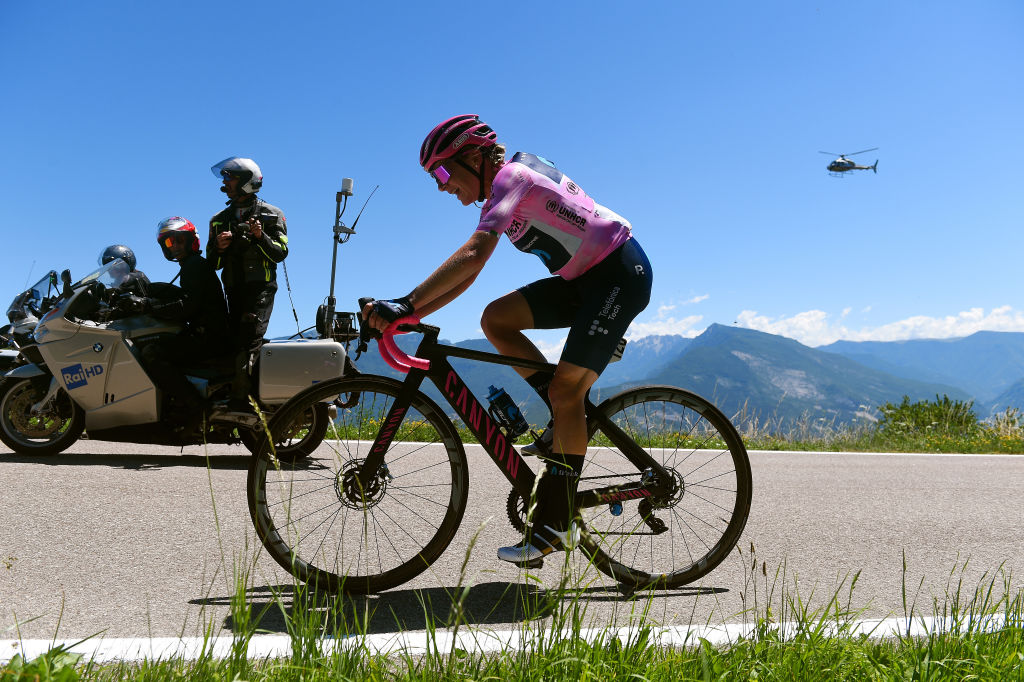Giro Donne makes step up with comprehensive live broadcast
Additional sponsorship enables better broadcast quality and quantity, with viewers able to watch much of key action unfold

The 2022 Giro d’Italia Donne was a race that had it all – a short time trial, sprint stages, a hilly stage that predetermined the GC, a summit finish and mountain stages with multiple climbs. Just as importantly, it was a race that could easily be followed as it happened because both the quantity and quality of the live broadcast was a stark improvement on previous years.
There were over 13 hours of racing plus post-race interviews and podium ceremonies broadcast from the ten stages, a big leap in coverage from the edition that played out less than two years ago during the COVID-ravaged 2020 season.
That was the year when the organisers of the race, then known as the Giro d’Italia Femminile or Giro Rosa, put their event on in September rather than cancelling outright for 2020 as many other events had. However, there were no live broadcasts at all from the Giro Rosa that year, violating new UCI rules requiring at least 45 minutes each stage at Women’s WorldTour races. In combination with a number of other organisational shortcomings, that meant that the Italian Grand Tour went down to 2.Pro status for 2021.
Italian sports broadcasting company PMG Sport came in as the new organiser ahead of the 2021 season. It rebranded the race as the Giro d’Italia Donne and improved many aspects, including adding a live broadcast of the women’s Giro for the first time in the race’s 34-year history. As a logical conclusion, the race regained its Women’s WorldTour status for 2022.
In 2022, helped by sponsorship from Eurosport and discovery+, the broadcast quality took another significant step up. In 2021, only the last 20-30 kilometres of each stage where broadcast, and a lack of 4G signal on the mountain stages meant that most of the GC action remained unseen. This year, the race no longer relied on the mobile network to relay the broadcast signal, giving a much more reliable broadcast especially in the mountainous areas. The race also added a camera helicopter. The results of all these changes were evident not just in the broadcast quality and quantity, but the response.
"The Giro was in fact followed with great passion and enthusiasm both along the roads of these 10 stages and through mainstream TV channels as well as vertical ones and streaming platforms," said Roberto Ruini, founder of PMG Sport and General Manager of Giro Donne. "Even without having today’s final aggregated data yet, we can say that the 2022 edition of Giro Donne has exceeded 20 million spectators, not counting the online audience."
All in all, most of the in-race action could be watched as it unfolded. One exception was stage 4 when eventual overall winner Annemiek van Vleuten (Movistar Team) channelled Johan Cruyff’s adage that attack was the best way of defence. When the live broadcast started with 42 km to go, Van Vleuten had already pushed ahead on the Colle del Barbotto in order to have breathing room on the technical descents, joined by Marta Cavalli (FDJ Nouvelle-Aquitaine Futuroscope) and Mavi García (UAE Team ADQ). Their advantage of over four minutes on the next group meant that these four riders finished the race on the overall podium.
Get The Leadout Newsletter
The latest race content, interviews, features, reviews and expert buying guides, direct to your inbox!
The three mountain stages with the Passo Maniva finish followed by two stages with multiple Alpine climbs were good television: Juliette Labous (Team DSM) came back in the general classification with a stage victory from the breakaway on her way to a ninth place overall, and Kristen Faulkner (BikeExchange-Jayco) went on the attack for two days in a row, chasing the mountain jersey and a second stage victory after winning the opening time trial. As Faulkner soloed to victory and into the green jersey on stage 9, there was also a long-range fight for the last podium spot as Elisa Longo Borghini (Trek-Segafredo) took her courage in both hands in the final 20 km but came up short against García.
As Longo Borghini said after animating the race "I think our duty as riders, as athletes, is also to put on a show" and with improved coverage this year viewers had the opportunity to watch far more of it unfold.
Lukas Knöfler started working in cycling communications in 2013 and has seen the inside of the scene from many angles. Having worked as press officer for teams and races and written for several online and print publications, he has been Cyclingnews’ Women’s WorldTour correspondent since 2018.